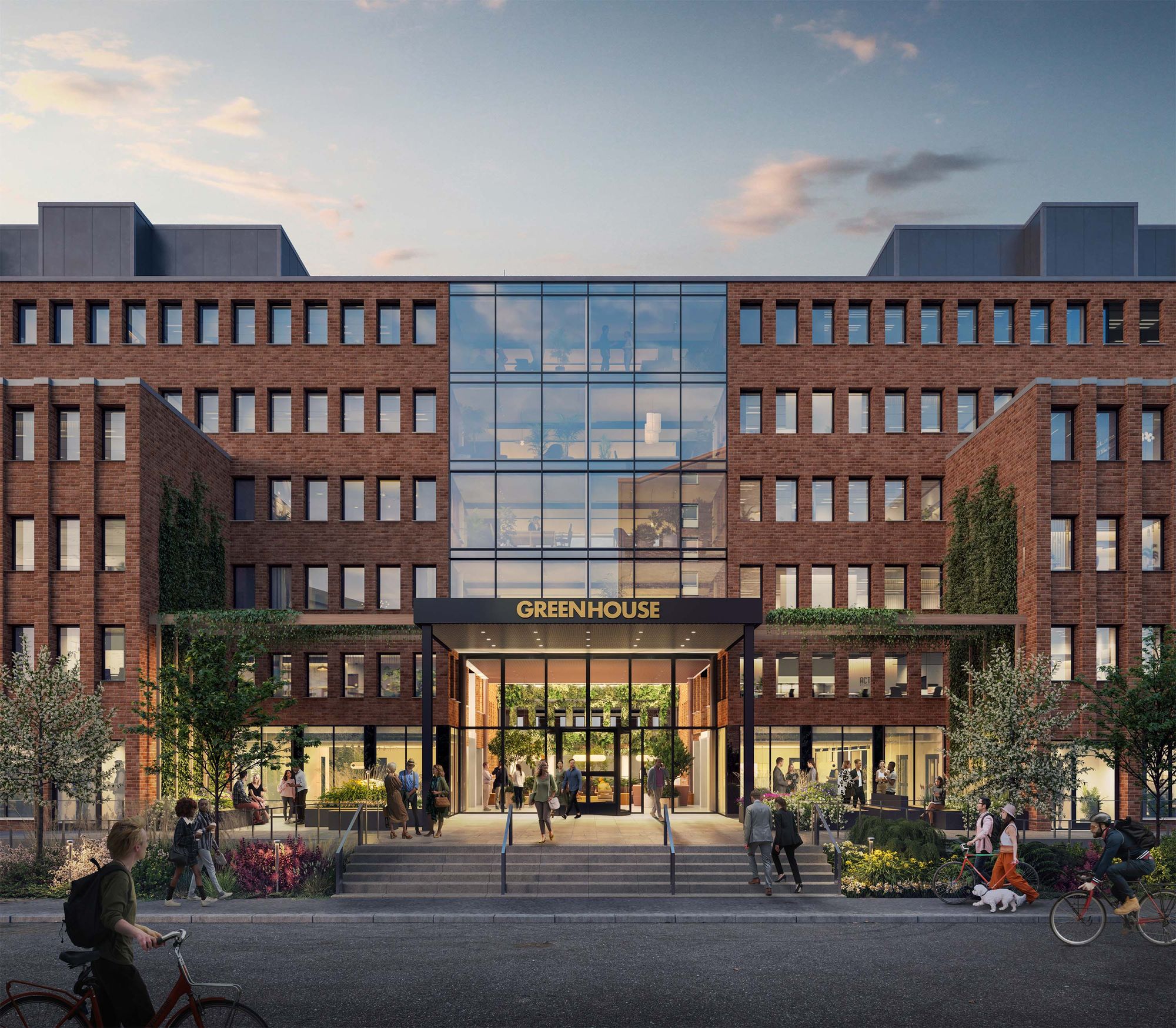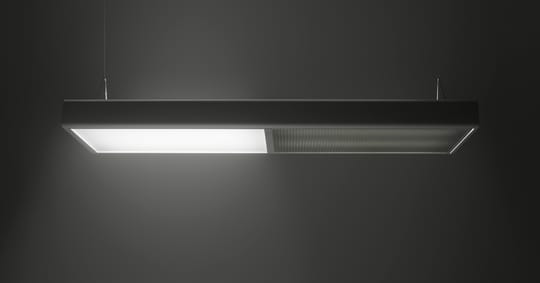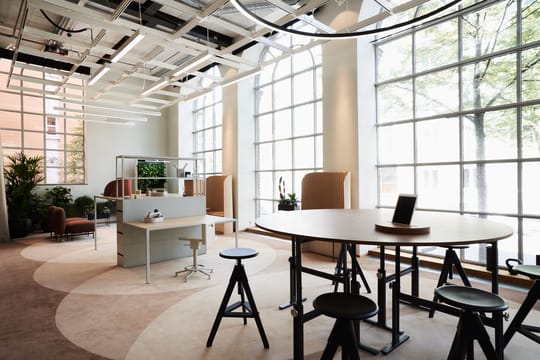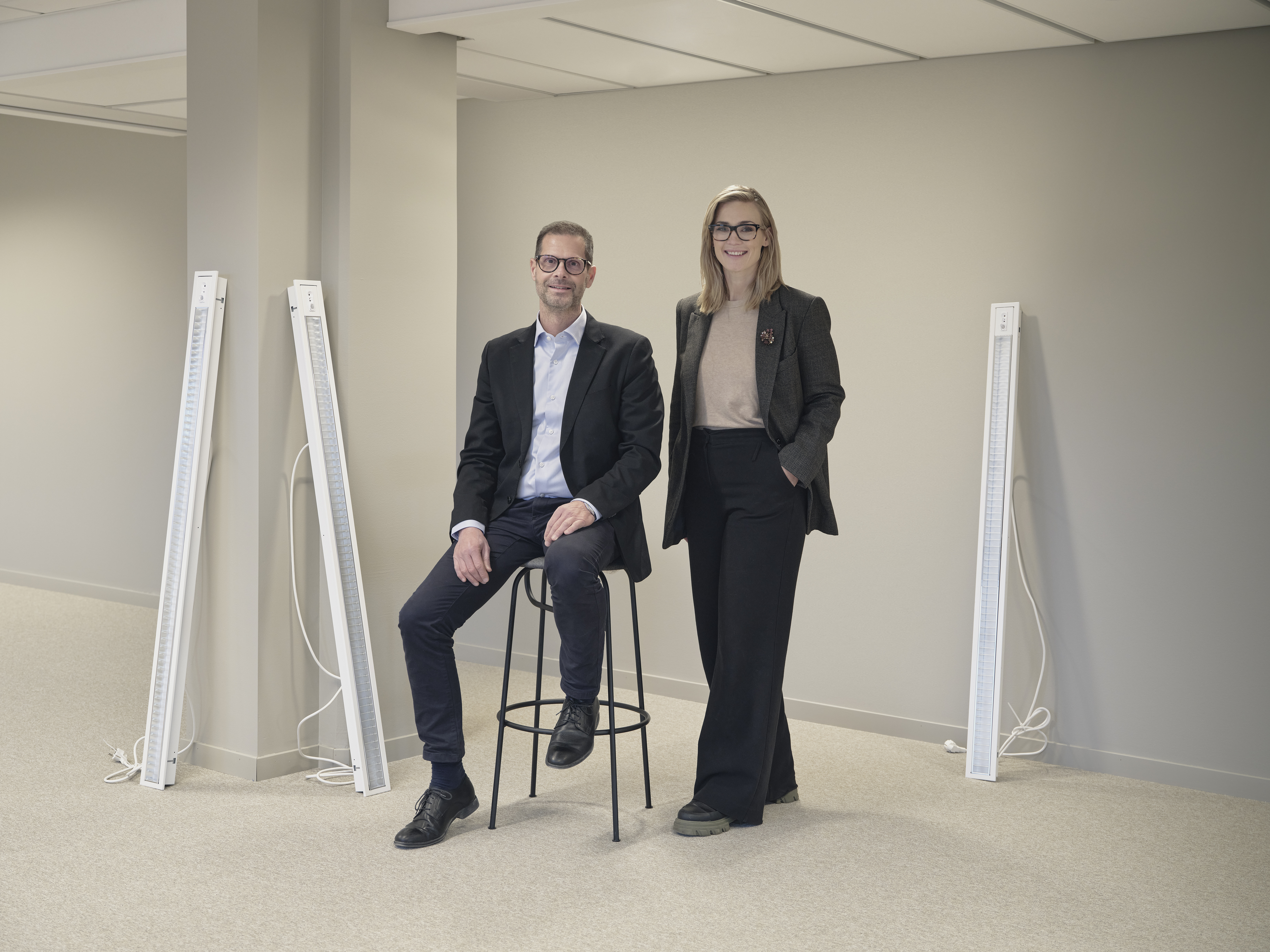
Greenhouse greatly reduced the climate impact by reusing 2 700 luminaires
Sustainable buildings are the only way forward, just ask property developer Humlegården Fastigheter. With three keywords in mind – reusing, recycling and upcycling, Humlegården developed the concept surrounding Greenhouse in Solna Strand. A project focused on refurbishing what is already there and utilising smart lighting control systems to future-proof the building for years to come, and reaching environmental savings of as much as 75 tonnes of carbon dioxide.
Creating a space for people and nature
Greenhouse is a modern workspace of up to 20,000 square meters with occupancy starting at the end of 2023. It offers a wide range of conference rooms and shared workspaces in an open environment. When navigating the space, you constantly enjoy the change between indoor and outdoor surroundings. The building is defined by its great variation between open landscapes and more intimate meeting spaces, while simultaneously making space for non-work related activities such as yoga, meditation, and sauna. The result is a dynamic work environment generating both great focus and relaxation.
"We want to create places where people wish to be and want to return. This requires exciting contexts and a changing environment that supports modern ways of working and is attractive to employees", says Anna Kullendorff, Business development manager at Humlegården.
Recycling and reuse in mind
Being an beautiful old brick property, the goal of this project was to modernise it in a sustainable way, while still preserving the value of its history. This included, for example, keeping and reusing the interior ceilings, glass partitions, and doors. Since the ceilings were reused, a question arose. Could the luminaires also be restored and updated to meet today’s standards? Fagerhult got involved at an early stage of the project to convert and transform the old luminaires into modern presence- and daylight-controlled LED luminaires.
"By refurbishing the luminaires, we were able to achieve significant environmental and economic savings. We could keep the electrical installations, avoid new wiring and making new holes in the ceiling. To future-proof the building, we also installed our plug-and-play lighting control system, Organic Response in every luminaire. Incorporating a control system, ensures a future-proof solution since it creates the possibility to add on services and integrations to a Building Management system, if needed", says Kjell Wallin, Lighting advisor, Fagerhult.
Clear goals paved the way for creative solutions
For Fagerhult, Greenhouse is the largest refurbish project to date.
"Collaborating with a property developer who expresses such clear goals regarding sustainability and refurbishment is exciting. With over 2 700 luminaires, in three different models, being refurbished, we had to think creatively to find practical and sustainable solutions", says Jessica Wahlberg, Fagerhult's Regional manager in Stockholm.
However, transporting the luminaires from Solna to Fagerhult and back would entail significant greenhouse gas emissions and undo the environmental benefits of refurbishing the luminaires. So, with sustainability in mind – Fagerhult came up with a different, slightly unconventional, solution.
A full-scale production line on-site
A full-scale production line was created at Greenhouse where Fagerhult planned and organised all the set-up in close collaboration with the on-site electricians for an efficient workflow. We considered everything from easy transportation of the luminaries inside the building to management of functional tests and recycling by the knowledgeable assemblers.
All the old luminaries were disassembled, the luminaire body was reused, and all excess material were sorted into different fractions and recycled. The old light sources were replaced with new LEDs and integrated Organic Response sensors to save energy. Everything was customised to fit into the old luminaire body.
 "On site we found old bread cages that fit into the elevators, these were reconstructed in order to safely transport the luminaires". Kjell Wallin, Lighting advisor, Fagerhult
"On site we found old bread cages that fit into the elevators, these were reconstructed in order to safely transport the luminaires". Kjell Wallin, Lighting advisor, Fagerhult
"This project required a lot of creative solutions and quick thinking. For example, while transporting the luminaires between different floors we needed to develop special cages since the elevators were too narrow to fit a forklift. On site we found old bread cages that fit into the elevators, these were reconstructed to safely transport the luminaires", says Kjell Wallin, Lighting advisor, Fagerhult.
And since we never compromise on safety, Fagerhult also ensured the technical capabilities and safety of the refurbished luminaires. All new luminaire parts were tested at our laboratory according to current standards, which made the assembly at Greenhouse easy and efficient. After a luminaire had been rebuilt, complementary and final tests were also carried out on site. We always focus on high quality in our lighting solutions, regardless of them being old or new.
Environmental savings
By reusing parts from the luminaires, keeping the old electrical installations, and not needing to make new holes in the ceiling or new cable installations, the refurbishment of the luminaires at Greenhouse has led to significant environmental savings.
"By working with Fagerhult to reuse the existing luminaires we have saved 7.1 tons of material and 2,297 megawatt-hours of energy over a 20-year lifecycle. If we also include the environmental savings from fewer transports and less packaging, the environmental benefit becomes even greater", says Clas Boudrie, Project manager at Humlegården.
Greenhouse is proof that big steps can be taken within sustainable property development - all through close collaboration, commitment and by embracing an unconventional mindset to make it happen.
Read more about Greenhouse here
TEXT SUSANNA MAGNUSSON
PHOTO JANSIN & HAMMARLING

Read more about Re:Furbish
Re:Furbish is an initiative within Circular solutions – one of our four sustainability focus areas. By upgrading and improving existing luminaires, we can jointly create major benefits for the climate, the project’s economy, and future lighting comfort.
Read moreRelated News

World of Volvo lights up Gothenburg – go behind the scenes in planning
When World of Volvo opened its doors in April 2024, it marked the culmination of an extensive and unique lighting project that started back in 2019. The primary construction material of the 22,000 square metre building is wood – and its rounded, organic geometry and advanced design challenge traditional architectural norms. Through close collaboration with Granitor and Vinnergi, Fagerhult has played an important role in bringing the innovative building to life, which is now a bright landmark in Gothenburg. Traditional, but at the same time innovative – and with natural materials as common denominators. World of Volvo was designed by the internationally renowned architectural firm, Henning Larsen and inspiration for the design was taken from the Swedish concept Allemansrätten (The right of public access to nature). The building stands on a solid concrete foundation, with the supporting structure comprised of glulam beams and cross-laminated timber. The glass façade acts as a transparent wall to the world outside, allowing natural sunlight in and to create a warm and inviting atmosphere. The design of World of Volvo contributes to a vibrant meeting place that fosters interaction between people and ideas. In a building that interweaves artistic creativity and technological innovation, light plays an important role in enabling meetings between people – where creativity is promoted and new ideas are take form. Video “We have worked on large projects before, and World of Volvo is something completely unique,” says Mikael Johansson from Fagerhult, who served as the technical sales representative for the project. With responsibility for a large part of the general lighting both indoors and outdoors, it was up to Fagerhult to take on this unique lighting project. The mission of World of Volvo presented several technical and aesthetic challenges, as light has not only had to meet functional requirements, but also needed to be harmonised with the building’s unique architecture. “We really had to think hard in this project,” says Johansson. “The huge window sections provide a lot of natural light, but we have different seasons in Sweden with varying amounts of sunlight. We have therefore adapted the lighting so that it emphasises and highlights the building in the dark, but also interacts well with the natural light that seeps through the glass sections.” Gallery 1(2) Create, test and adapt for a constantly changing building World of Volvo was designed as a constantly changing building, and an early goal during the planning stage was to create a space where people could socialise, enjoy themselves, develop and be entertained. Since the opening day, visitors are able to enjoy temporary and permanent exhibitions, cultural events, lectures, conferences, and dining, which requires different types of lighting adapted for each individual space and purpose. “We have created, tested and tried out a lot of lighting at World of Volvo, since the building’s round shapes and varying ceiling heights have demanded a high degree of customisation,” explains Hampus Simmons from Simmons Ljusstudio, Head Lighting Designer in the World of Volvo project. “Each room and surface has been equipped with unique lighting solutions in a flexible system. It was important for us that the lighting could be adaptable and re-orientable over time – for example, when the exhibition changes or when new parts are added.” Quote Wood is a favourable material to work with when it comes to lighting. The colour temperature has been adapted to ensure that the wood does not look too yellow, but otherwise the natural material and the lighting have been seamlessly harmonised. The different heights, surfaces and lighting uses – combined with the unique architecture and its visible construction – proved to be a major challenge. It required well thought-out solutions since the focus was to be on the actual light provided and its emphasis on the building – and not the luminaires. At World of Volvo, there are no ceilings that can hide the work behind the lighting. In many buildings it is possible to conceal brackets, cables and cords in the ceiling – but that was not an option here. For this reason, it has been very advantageous that our production facility is located in Habo, as it has enabled us to quickly develop custom brackets and luminaires, including specific lengths and light colours. “Having our production and product development in such close proximity has been a huge advantage throughout the World of Volvo project”, explains Mikael Johansson. Quote Vinnergi The lighting enhances the unique architecture of the building According to Pontus Mazetti from Vinnergi, who is responsible for the electrical design at World of Volvo, the project has involved collaboration and good cooperation between the client, the architect, the construction contractor and the supplier. “Since the start of the project, we have all had ambitious visions for World of Volvo, and the results truly reflect the commitment all parties have shown. Together we have created lighting that enhances the experience of the building, while maintaining its function and aesthetics year after year,” says Pontus. Gallery 2(2) LEED Gold and WELL certifications were obtained for the project, which involved solutions that reduce energy consumption and promote the well-being of everyone who spends time in the building. Fredrik Jernstedt, Lead Project Manager at Granitor, notes that intelligent, long-term choices and sustainable processes have been common goals for all parties. “With a building that is meant to change, depending on the exhibitions and events being held, it was crucial that World of Volvo’s lighting solutions last over time and can be adapted as needed. We have created a flexible system where it will be possible to adjust the light settings without having to rebuild the entire installation,” explains Fredrik Jernstedt. What makes World of Volvo particularly impressive is not only the design and shape of the building, but also how it is highlighted by its lighting – especially during the evening. It becomes even clearer that World of Volvo is a visual landmark, visible from the motorway and other parts of the city. “We have managed to create a lighting solution that is not only functional, but also enhances the building’s unique architecture. It’s really a powerful feeling to drive past World of Volvo in the evening,” says Mikael Johansson, Fagerhult. The light highlights the building’s organic forms, highlights Volvo’s iconic vehicles, and creates an innovative atmosphere that reflects both Volvo’s and Fagerhult’s values of sustainability, innovation and respect for nature. World of Volvo now stands as a landmark in Gothenburg – and as an example of how architecture, nature and lighting can interact in a way that both impresses and inspires. And Fagerhult continues to light up Sweden’s most iconic places.![SKRYTA [slow design] - holding it together](https://www.fagerhult.com/cdn-cgi/image/width=540,quality=80,fit=crop,onerror=redirect/globalassets/global/_news/2019/skryta-slow-design/header.jpg)
SKRYTA [slow design] - holding it together
In a time when ingrained behaviours and patterns are being questioned, alternatives are needed. Something, or someone, that puts the focus on things of importance. SKRYTA [slow design] demonstrates with its history, that you don't always have to do things as you've done before. And thinking circularly may be the only straight way forward. NOT SEAMLESS Probably no one thought that lamps made of old donated jeans would be adorning the offices of the prestigious advertising firm Forsman & Bodenfors. And perhaps not the least Maria Zeilon, textile designer, and Lill O. Sjöberg, MFA designer, who together are SKRYTA [slow design]. Their shared interest in innovation and crafts has led them on a sustainability journey that they don't really know where will end. But they know where it starts. "We were asked to participate in a regional project in 2013–14, where waste material from the Red Cross's operations would be put to use," says Lill. "When asked, we both wanted this to be something that could be repeated, that would not just be a one-off event. Textiles are the material most donated and that are not always sold. We chose jeans to start with, and began experimenting with different patchworks with the fabric. We finally decided on denim seams, which we tried various ways braid, and from these tests, the first lamp shades emerged." "In connection with this, we received an offer to work with the Swedish Prison and Probation Service in Borås, and we really wanted to give it a try," says Lill. "We were given access to a textile hall at the prison with a number of inmates. We established very good contact and succeeded with our project. We think it was because we turned things around and asked, 'what are they capable of doing?' instead of presenting something and saying 'can you sew this?' Our idea was well suited to the purpose of the whole project. The lamp was easy to make, they were had to work together and learn new techniques." In each lamp there is a leather tag with a number so that you can see who made the lamp. From the start, SKRYTA was strict about the participants signing their lamps, so that they could feel pride and a sense of participation in what they had done. Q Lill After the first project was finished and the Prison and Probation Service's textile workshop was closed down, the duo applied for another collaborative project. Maria had a contact at the help organisation Göteborgs Stadsmission, where there were workshops for job training, and the pieces then fell into place. Within a week of their first meeting with Stadsmission, they started making samples together. With SKRYTA's experience with the Prison and Probation Service, everyone involved was aware that certain demands could not be placed on those participating. "And we continued with the reverse mindset – what can the participants do?" Maria explains. "So that it's always on the terms of the participants, which is incredibly rewarding. And without sacrificing the design." Img 1 THE PROCESS OF A LAMP When the designer duo adds new models to their collection, they work out the design, instructions and dimensions of the lamp shade. They then construct a lamp at a leisurely pace, taking their time. Job training is not rushed either. "Making a lamp shade can take 6 to 9 hours, more or less a day's work if you have all the materials and tools in place," says Maria. "We think it should be like knitting, something that you can put aside and then take up again. With the start-up work for each new lamp shade version, we now have a fixed range. However, the products available can be adapted in colour and size to better suit various preferences. Each project is typically for 1 to 10 lamps. As production time can vary, production is just right for the way our company is set up." "In addition to waste material, we also engage small local businesses. The company that makes the braids for the lamps, for example, is here in Gothenburg," says Lill. "We want to keep it that way for the entire process. It feels good when you've started thinking along those lines – how we can support the community and create awareness of the craft. It's another aspect of our product. We were quite nervous when we showed our lamps the first time, since delivery time is so long – things are a bit different. But it's just added our to story and reinforced our concept. You choose us because this is what you want." Img 2 GLOBAL AWARENESS Among SKRYTA's suppliers are Göteborgs Stadsmissionen, an internationally known producer of birch-bark products in Fjärås and carpet manufacturer Kasthall in Kinna. All these local partners have provided insight and feedback that have helped the company move forward. Even far beyond Sweden's borders. "We've had a showroom of sorts at Kasthall, where we installed the lamps for architect lunches but never taken them down," says Lill. "It's been an incredibly good platform for us, having the opportunity to show our wares to architects. We wanted their feedback – 'what do we need to think about?' They told us that we need to have more solutions than just E27, such as a light engine. We had to Google to find out what a light engine was! We found the Dino at Fagerhult and after that, we modified our lamp shade frame so that you could choose either the light engine or E27." "We now have projects all over Europe with these lamps, and it has spread," says Maria. "We've just participated in an exhibition of Nordic sustainable companies at the Swedish Embassy in Berlin, which was great fun." There is completely different awareness nationally and internationally about this way of thinking. Q Maria REUSE, REDUCE, RECYCLE Although the duo has now been active with their work for almost 6 years, it is now that they are experiencing a real boost. "During the past year, we're really seeing a different interest," says Maria. "The work we've put in is now starting to be more in tune with the rest of society. We were a bit ahead of our time – but now we're exactly where we need to be. For example, we won the sustainability award Nyttigaste Affären 2019 in collaboration with Ergon at Göteborgs Stadsmission with our socially sustainable business concept. (Link http://nyttigasteaffaren.se/2019-ars-vinnare/ ) "We're mostly targeting the public sector or businesses, and those who buy our products have no objections to our prices or production rates," says Lill. "That's because they've heard the story behind the lamp, and they consequently understand the value behind it. We want to be very clear about that, because we get a lot of requests from people who want to borrow our lights. But we want them to retain their intrinsic value, that they should not be taken out of their context." In the future, SKRYTA would prefer to scale up the company rather than expand with other products. "We've received queries from different customers who want larger quantities of our products, which means we have some decisions to make," says Maria. "We hope to work this out in a good way. But regardless of the project, we always try to be as circular as we can. We've even found a solution that allows us to reuse leftover materials from our lamps to make other lamps. That's probably the height of being circular!"



